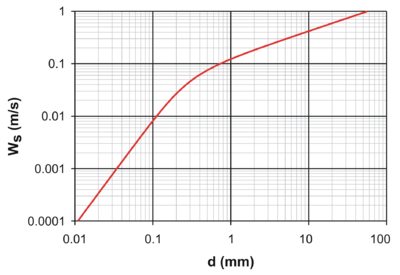Sedimentation rate
Under the sedimentation - Sink - or fade rate (also rate of descent ) is the vertical velocity , at which a particle within a fluid medium (settling sediment ). This is particularly important for particle size analyzes and the associated mechanical separation processes ( centrifugation , density gradient centrifugation , decanting , sedimentation ).
Above all in biology, the sedimentation speed is given in Svedberg .
calculation

the curve shows different areas, since the Reynolds number and thus the formula for the drag coefficient change with the grain diameter
In the case of purely gravitational sedimentation (i.e. without centrifugation), the sedimentation speed remains constant as soon as the friction force, which increases with the speed, compensates for the gravitational force that accelerates the particle.
The calculation is based on spherical particles that sediment in an infinitely expanded liquid, in which neither walls nor neighboring particles influence the speed:
The sedimentation speed depends on:
- the density ρ p of the particle and the density ρ f of the fluid
- the acceleration due to gravity g
- the diameter or equivalent diameter d of the particle
- the flow resistance coefficient ( drag coefficient ) C D .
- with the viscosity of the fluid contained there (see below)
The drag coefficient C D in turn depends on the Reynolds number :
- for low sedimentation velocities or Reynolds numbers (Re <0.5; laminar flow ), C D = 24 / Re applies . In this case, the sedimentation speed can be calculated using Stokes' equation ; it changes with the square of the particle radius or the equivalent diameter.
- between these two ranges (0.5 <Re <1000) there is no simple formula for C D , but there are various empirical formulas, e.g. B. C D = 18.5 / Re 0.6 .
- for high sedimentation velocities or Reynolds numbers (1000 <Re <200,000, Newton range), C D = 0.44 (for balls). In this case the sedimentation speed changes with the square root of the particle radius or the equivalent diameter, see formula above. There is a turbulent flow .
As a general approximation for the Stokes, Transition and Newton ranges, the following formula can be used:
Individual evidence
- ^ Peter C. Heinrich, Matthias Müller, Lutz Graeve: Löffler / Petrides Biochemistry and Pathobiochemistry . Springer-Verlag, 2014, ISBN 978-3-642-17972-3 , pp. 92 ( limited preview in Google Book search).
- ↑ a b c d e Klaus Luckert: Manual of the mechanical solid-liquid separation . Vulkan-Verlag GmbH, 2004, ISBN 3-8027-2196-9 , p. 106 ( limited preview in Google Book search).
- ↑ Ralf Takors: Annotated collection of formulas for bioprocess engineering . Springer-Verlag, 2014, ISBN 978-3-642-41903-4 , pp. 118 ( limited preview in Google Book search).




